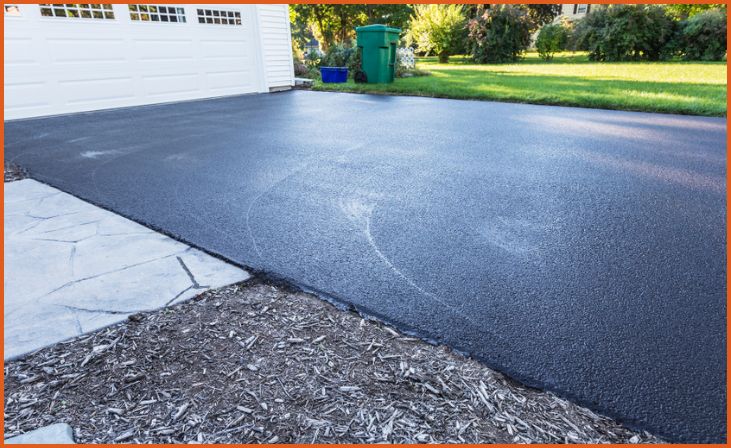Summer is the ideal time to ensure your asphalt surfaces are in top condition. The combination of heat and increased traffic can lead to significant wear and tear, making maintenance crucial. By following the right strategies, you can extend the lifespan of your asphalt, enhance safety, and maintain a pristine appearance. In this guide, we’ll explore the seven best tips for summer asphalt maintenance, covering everything from regular inspections to preventive measures that protect against the season’s harsh conditions. Whether you’re a property owner or manager, these practical tips will help you keep your asphalt surfaces in excellent shape throughout the summer months.
7 Best Tips For Summer Asphalt Maintenance
Regular Inspections

Conducting regular inspections is the cornerstone of effective asphalt maintenance. During summer, the intense heat can cause asphalt to expand, leading to cracks and other forms of damage. You can find these problems early on and take action to fix them by doing routine inspections, ideally once a month. Look for signs of cracking, potholes, and surface deformation. Additionally, pay attention to areas with standing water, as poor drainage can exacerbate asphalt deterioration. By catching problems early, you can implement timely repairs, which are typically less costly and extensive than addressing major damage.
During your inspections, also check for signs of oil and fuel spills, which can soften and weaken the asphalt. Addressing these spills promptly by cleaning and applying an appropriate sealant can prevent further damage. Furthermore, regular inspections help in assessing the overall condition of the pavement, ensuring that it remains safe for vehicles and pedestrians. Involving a professional for a thorough assessment at least once during the summer can provide insights that may not be apparent during routine checks.
Read Also: Tips To Protect Your Driveway In Winter
Timely Repairs
Once you’ve identified issues through regular inspections, the next step is to perform timely repairs. If neglected, cracks and potholes can soon worsen and require more involved and costly repairs. Summer provides the perfect weather conditions for asphalt repairs, as the warm temperatures help the materials bond better. Use crack fillers and patching compounds to address minor damages promptly. For larger potholes, consider hiring a professional to ensure the repair is done correctly and lasts longer.
Addressing cracks and potholes not only improves the appearance of your asphalt but also enhances safety by preventing accidents caused by uneven surfaces. Moreover, timely repairs prevent water from seeping into the base layers of the asphalt, which can cause further damage during freeze-thaw cycles. Regular maintenance also includes sealing cracks to prevent them from widening due to thermal expansion. Ensuring repairs are done promptly can save significant time and money in the long run by avoiding major reconstruction projects.
Sealcoating
An essential preventative step that has to be included in your summertime asphalt care regimen is sealcoating. Through the application of a protective layer, the asphalt surface is shielded from the destructive effects of water intrusion, oil spills, and UV radiation. Your asphalt will last longer with sealcoating, which also improves the look of the material by giving it a shiny, black surface. Ideally, sealcoating your asphalt should be done every two to three years, depending on the amount of traffic and environmental factors it experiences.
During the summer months, when temperatures are regularly over fifty degrees Fahrenheit, sealcoat application is most effective. This guarantees the sealant will adhere properly and cure. Make sure the asphalt is clean and free of dirt, oil, and debris before applying the sealcoat. For more difficult stains, this can be accomplished by power washing and applying specialty cleaning solutions. Sealcoat application creates an equal, smooth surface that lowers the possibility of water collecting and ensuing damage. It also seals small surface fissures, preventing more serious harm to the asphalt.
Proper Drainage

Ensuring proper drainage is crucial for maintaining the integrity of your asphalt during the summer. Asphalt surfaces are susceptible to severe damage from standing water, which can result in potholes, fractures, and even structural failure. Inspect your drainage systems regularly to ensure they are functioning correctly. Clean out debris from gutters, drains, and catch basins to prevent blockages that could cause water to pool on the asphalt. If you notice areas where water tends to accumulate, consider regrading the surface or installing additional drainage solutions to improve water flow.
Proper drainage prevents water from seeping into the base layers of the asphalt, which can weaken the foundation and lead to more severe damage over time. It also reduces the risk of hydroplaning, enhancing safety for both vehicles and pedestrians. Implementing drainage solutions like French drains, permeable pavements, and sloping can effectively manage water runoff. Regular maintenance of these systems is essential to ensure they remain effective, especially during heavy summer rains. You may greatly increase the longevity of your asphalt surfaces by giving adequate drainage first priority.
Temperature Management
Managing the temperature of your asphalt is another key aspect of summer maintenance. Heat waves that are too high can weaken asphalt, resulting in surface deterioration and more wear and strain. One way to mitigate this is by applying light-colored reflective coatings that help to reduce the surface temperature. These coatings reflect more sunlight and absorb less heat, keeping the asphalt cooler and less prone to damage. Additionally, scheduling heavy traffic during cooler parts of the day, such as early morning or late evening, can help minimize the stress on the asphalt.
Regular watering of asphalt surfaces during peak heat periods can also help to lower the temperature, though this should be done with caution to avoid creating slippery conditions. Implementing shaded areas or planting trees around the asphalt can provide natural cooling effects, reducing the overall temperature. Using heat-resistant asphalt mixes for high-temperature areas can also be beneficial. By effectively managing the temperature, you can prevent common issues like softening and rutting, ensuring your asphalt remains in good condition throughout the summer.
Traffic Control
Controlling traffic flow is essential for maintaining asphalt surfaces during the summer. High temperatures combined with heavy traffic can accelerate wear and tear, leading to premature damage. Implementing traffic control measures such as weight limits, speed restrictions, and designated parking areas can help distribute the load more evenly across the asphalt. Additionally, using signage and barriers to guide vehicles and prevent them from driving on vulnerable areas can minimize stress on the pavement.
During summer events or peak traffic periods, consider temporary solutions like rubber mats or protective overlays to safeguard the asphalt from excessive wear. Regularly changing traffic patterns can also prevent specific areas from bearing the brunt of the load continuously. For commercial properties, coordinating with delivery schedules to avoid peak heat times can reduce the impact on the asphalt. Proper traffic control not only prolongs the lifespan of your asphalt but also enhances safety by reducing the risk of accidents caused by damaged surfaces.
Read Also: Tips For Quality Asphalt Pavements
Regular Cleaning

An essential component of summertime asphalt care is routine cleaning. The accumulation of dirt, debris, and oil spills on the surface can cause degradation and discoloration. To maintain the best possible appearance and shield your asphalt from long-term harm, set up a regular cleaning program. To properly remove impurities, use sweeping, power washing, and specialist cleaning solutions. Spills of oil or gasoline should be cleaned up right once since they might weaken the asphalt and harm the structure.
Cleaning not only improves the appearance of your asphalt but also enhances its functionality by preventing blockages in drainage systems. Regular removal of debris ensures that water flows smoothly off the surface, reducing the risk of water damage. For commercial properties, consider implementing a more frequent cleaning schedule during peak usage times to maintain a professional and inviting appearance. By prioritizing regular cleaning, you can protect your asphalt from environmental factors and extend its lifespan significantly.
Conclusion
Maintaining your asphalt during summer is essential for its longevity and appearance. Regular inspections, timely repairs, and preventive measures can make a significant difference. By implementing these seven tips, you’ll ensure your asphalt surfaces remain durable, safe, and visually appealing, even under the harshest summer conditions. Take proactive steps now to enjoy smooth and well-maintained asphalt all season long.
FAQs
Why is summer a critical time for asphalt maintenance?
The heat and increased traffic during the summer can hasten the deterioration of asphalt, necessitating maintenance to avert damage and extend lifespan.
What preventive measures can protect asphalt during summer?
Applying sealant, filling cracks, and ensuring proper drainage are key preventive measures to protect asphalt from summer’s harsh conditions.



